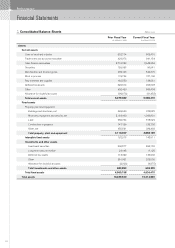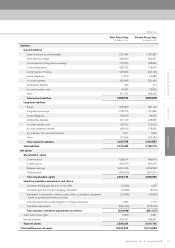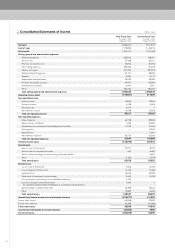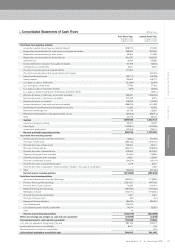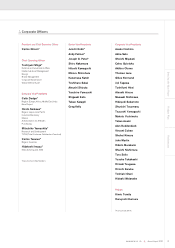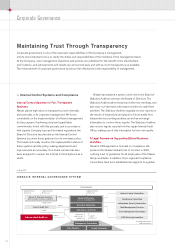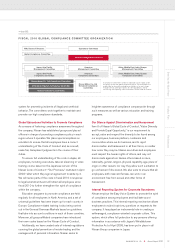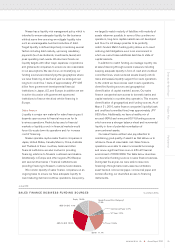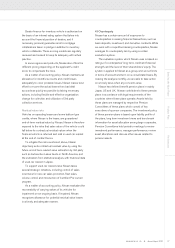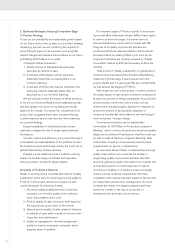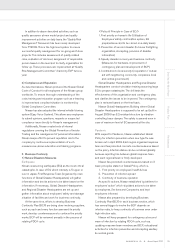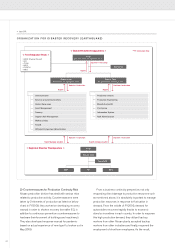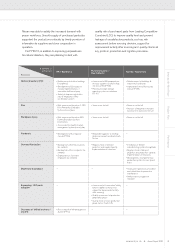Nissan 2010 Annual Report Download - page 36
Download and view the complete annual report
Please find page 36 of the 2010 Nissan annual report below. You can navigate through the pages in the report by either clicking on the pages listed below, or by using the keyword search tool below to find specific information within the annual report.
34
Efficient, Independent Internal Audits
Nissan has established Global Internal Audit unit, an
independent Department under the direct control of Chief
Operating Officer (COO), to handle internal auditing tasks.
Under control of Chief Internal Audit Officer (CIAO), audit
teams set up in each region carry out efficient and effective
auditing of Nissan’s activities on a group wide and global
basis. Audits are implemented based on Audit plan
approved by Operations Committee and the results are
reported to COO and other related parties. Additionally,
Audit plan and the results are also reported to Statutory
Auditors on a regular basis.
The Principle and Approach to Corporate Risk
Management
For Nissan, the term risk refers to any factor that may
prevent the Nissan Group from achieving its business
objectives. By detecting risk as early as possible, examining
it, planning the necessary measures to address it and
implementing those measures, we work to minimize the
materialization of risk and the impact of damage if it
realized. Risk management must be a real-world activity
closely linked at all times with concrete measures. Based on
its Global Risk Management Policy, Nissan carries out
activities on a comprehensive, group wide basis.
In order to respond swiftly to changes in its business
environment, Nissan set up the department in charge of risk
management, which carries out annual interviews of
corporate officers, carefully investigating various potential
risks, evaluate impact, frequency and control level and
revising the Corporate Risk Map. An executive-level
committee makes decisions on corporate risks that should
be handled at the corporate level and designates “risk
owners” to manage the risk. Under the leadership of these
owners, appropriate countermeasures are developed and
implemented. Additionally, the board member in charge of
internal controls (currently, COO) regularly reports to the
Board of Directors on progress being made.
With respect to individual business risks, each division is
responsible for taking the preventive measures necessary to
minimize the frequency of risk and its impact when realized
as their own business activities. The divisions also prepare
emergency measures to put in place when risk factors do
materialize. Nissan Group companies in Japan and overseas
are strengthening communication and sharing basic
processes and tools for risk management, as well as related
information, throughout the group.
Additionally, “Corporate Risk Management” web site was
launched on Nissan’s intra net in 2009, which puts out risk
management information to Nissan employees including US,
Europe and major subsidiaries in Japan.
Risk Management Measures & Actions
1. Risks Related to Financial Market
1) Liquidity
Automotive
Liquidity risk is one of major risks facing any business
and 2008-2009 credit crisis has heightened importance
of managing this risk. Nissan recognizes this risk and has
put in place several countermeasures to manage this
risk.
Automotive business must have adequate liquidity to
provide for working capital needs of day-to-day normal
operations, capital investment needs for future expansion
and repayment of maturing debt. Liquidity can be
generated through internal free cash flows or external
borrowings. As of the end of fiscal year 2009 (March 31,
2010), Nissan’s automotive business had JPY 30 billion
of net automotive debt (compared with JPY 388 billion
as at March 31, 2009). Nissan’s automotive business
thus needs to borrow funds externally from banks and in
capital markets to meet its liquidity needs. To the extent
financial markets are frozen or credit is not available, this
creates liquidity risk for Nissan.
For automotive business, Nissan raises financing
through several sources including bonds issuance in
capital markets, long and short-term loans from banks
and commercial institutions, long-term loans from
government developmental financial institutions,
short-term commercial paper issuance, and committed
credit lines from banks. A significant portion of the
financing for the automotive business is raised by parent
company, Nissan Motor Co Limited (NML), in Japan with
some financing raised overseas by NML’s automotive
subsidiaries’.
In fiscal year 2009, automotive business raised JPY
311 billion in new long-term financing from various
funding sources described above while long-term debt
repayments amounted to JPY 102 billion. As of March
31, 2010, automotive business’ liquidity consists of cash
balance of JPY 747 billion and unutilized committed
credit facilities of approximately JPY 547 billion.
Additionally, short-term loans and commercial paper
continues to be available as incremental funding sources
to meet liquidity needs. As of the end of fiscal year,
commercial paper outstanding was JPY 25 billion which
is significantly lower than our peak utilization of
approximately JPY 516 billion in prior years. During the
fiscal year, automotive business reduced its reliance on
short-term loans and commercial paper to 7.5% of total
debt as at March 31, 2010 compared to 29.6% as at
March 31, 2009. Maturity of long-term debt is well
spread out with maturity in any one year not exceeding
JPY 400 billion.




